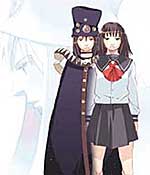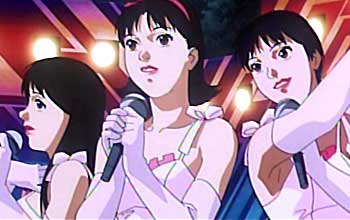
More celebrated anime professionals overshadow the work of Sadayuki Murai. Accolades rained down on director Satoshi Kon for "Perfect Blue," but at his base sat Murai's screenplay. The writing for "Cowboy Bebop" propelled chief writer Keiko Nobumoto into the spotlight, but Murai's "Pierrot Le Fou" episode certainly stands out in this consistently well-written series. Kon's new project, "Millennium Actress," again carries a Murai pen credit, though deserved critical acclaim has focused on Kon's deft storytelling rather than the structural dexterity of the script. Murai currently holds a position on the joint Japan/US writing staff for the new "Astro Boy" television series being developed by Sony, but press leaks emphasize the aesthetics of this new version in relation to Tezuka's original creation.
If this is any indication on how highly English-speaking audiences regard anime writers, the top result on a Google search for Sadayuki Murai is in French. But Murai's name does pop up on the English language web in connection to the screenplay for "Perfect Blue." He adapted Yoshikazu Takeuchi's novel for Kon's film only two years into his professional writing career, which began when he received a Young Screenwriters Award in an annual competition organized by Fuji TV. Since then his credits have included both live action and anime titles - usually with a supernatural bent - such as "Mokuyou no Kaidan" (Thursday Ghost Stories), a live action mystery, "Toilet no Hanako-san" (Haunted Junction), an animated series about a high school poltergeists, and episode ten of "Eko Eko Azarak," a live action demon hunter tale based on a manga by Koga Shin'ichi. Murai's more recent work includes a writing credit on Go Nagai's "Devilman Lady," and Kohei Kamitono's "Boogiepop wa Warawanai" (Boogiepop Phantom), another ghost story set at a high school.
"Perfect Blue," though certainly gory, marks a departure from typical Murai fare in that it deals with psychological violence rather than super-natural violence. "Millennium Actress" virtually eschews violence entirely and allows Murai to create a stirring dramatic text about human longing. Murai's future then may very well be linked to the cinematic whimsy of director Satoshi Kon.
For as much as his work engenders extremes, the man himself manifests a soft spoken and self-effacing manner. He's only about thirty years old and extremely gracious.
How and when did you become a writer?
Sadayuki Murai: I won a screenwriting contest that was held by Fuji Television. That's how a lot of writers get into the business. A long time ago it used to be that aspiring writers would begin their careers by work under a teacher. But that apprentice system is, for obvious reasons, too outdated. So they started a contest.
What was your winning screenplay?
SM: "The Classroom of Flightless Girls," a drama about a group of high school girls, what happens to them in class etc., a fairly serious type of story.
Is your experience mainly based in anime or in other mediums, for example T.V. dramas or feature films?
SM: I write for anime, T.V. dramas, movies - a bunch of different mediums. In Japan, it used to be that if you were writer you wrote for everything, dramas, movies, television, anime. Recently the specialties have been taking root and now people are focusing on specific mediums. But there are a few writers like myself who still work in various mediums.
Do you have any genres that you prefer?
SM: I'm often asked that, but for me character or uniqueness of the script is the most important. I'm far more interested in how the content of a story unfolds rather than a particular medium, which is actually why I am able to write for various mediums.
When you wrote the "Pierrot Le Fou" episode of "Cowboy Bebop," what kind of working relationship did you have with Keiko Nobumoto?

SM: Actually, Keiko Nobumoto started her career via the same writing contest. So even though we first met through "Bebop," we were familiar with one another's work and had developed a professional trust in each other. This was very helpful to our working relationship. As far as the roles we took in creating that episode, Nobumoto-san decided the basic theme or subject of each episode. For example, she would say, "This episode will include a clown," or "This episode will be centered around feng shui," or "The rival of the hero will appear in this episode." It was the job of myself and the other writers to expand on those points. Nobumoto-san asked me to create an assassin that would fight with Spike. I then took it from there and expanded on that storyline.
"Pierrot Le Fou" has a similarity to the work of Tim Burton, or the style of other "Batman" creators. It's also the title of an old Goddard movie. What were your main influences when writing the episode?
SM: Actually this is the first time I've heard that work compared to Tim Burton. In Japan I get asked a lot about Katsuhiro Otomo, the director of "Akira." I wasn't conscious of my similarities to Otomo and was surprised when other people compared us. I chose the title however because the director liked Jean Luc Goddard, and I chose the name Tompu because I'm a fan of Y.M.O. (Ryuichi Sakamoto's band Yellow Magic Orchestra). On Y.M.O.'s first album there's a song called Tompu, an allusion to the title of a Goddard film. In "Pierrot Le Fou," the assassin Tompu is brainwashed. In Japan, this is often compared to the psychological manipulation of "Akira."
The episode seems to be deconstructing the artifice of the theme park and, in a lot of ways, the shallow, cutsey markers of ravenously capitalist societies such as the US and Japan. Are these ideas indeed the genesis of the episode?
SM: Yes. In an amusement park there's a particular threat that something's lurking beneath the peaceful, artificial surface. I didn't intend any kind of political message. I just felt that the visual image of an amusement park at night when no one's around is very frightening and decided to set it there.
Like the "Pierrot" episode of "Bebop," Perfect Blue draws much of its narrative from the act of breaking down artifice. Could you expand on that idea?
SM: The setting for "Perfect Blue" is very close to the reality of Japan.
You mean idol culture?
SM: Yes.
In "Perfect Blue" Mima's manager says "There's no more use for idols these days." Since "Perfect Blue's" release three years ago, Morning Musume and other prefabricated idol groups have been coming out in droves. Can you compare the idol culture of "Perfect Blue" to what is happening now in the entertainment industry?
(Editor's Note: Morning Musume is prefabricated girl pop group of plain singing girls of various ages that is extremely popular and associated with bringing Japan out of the economic doldrums. The lyrics to one of their hits are about Japan's bright future.)
SM: The type of idol I was writing about in "Perfect Blue" is a completely different kind than the idols who are being presented today. The idols of "Perfect Blue" are the kinds that were popular around ten years ago, like Seiko Matsuda.
(Editor's Note: Seiko Matsuda could be called the Madonna of Japan. She had a degrading one-liner in "Armageddon" as a Japanese tourist in a taxi: "I want to go shopping.")
SM (continued): The kind of figures that appeared around the same time as Seiko Matsuda have been in the business for about ten years but have ceased being able to sell. About two years ago idols started to not even be recognized unless they could act in popular dramas. Mima and her manager are struck with this reality and they can't escape from that old idea of what an idol is. The world of "Perfect Blue" is composed of the kind of idols that wore frilly, gaudy dresses and would have gone into extinction were it not for the obsessive otaku that show up to each event. They aren't surviving in the mainstream media but rather the media underworld of otaku culture. That's where Mima got her success. She's famous among the otaku but to the rest of the world she isn't famous at all. Nobody notices her when she gets on the train. Her agency wants to push her into major stardom and puts her in a T.V. drama but she herself became popular in the otaku world and really doesn't want to leave it.

The television show in which Mima has a small role bears similarities to "Silence of the Lambs." Is this conscious? And if so, are you referencing the very style of film from which you borrow to make "Perfect Blue"?
SM: Oh yes. That was conscious, and half parody. But it's also a parody of the Japanese T.V. drama world at that time. At that time, or actually after "Silence of the Lambs" came out, several dramas appeared that were inspired by it. Even though they were a big hit with the general public, to the maniacs they came off as extremely cheap. That's why there's a line in the film that says something like, "why does it always turn out like this when it's done in Japan?" That was a little sarcasm directed at Japanese television dramas.
What do you think about the state of Japanese T.V. dramas? What kind of problems do you think exist within the industry?
SM: America is probably the same way, but everything in Japan is based on ratings. Because of the strong pursuit of ratings, stories aren't accepted unless all viewers can understand them. For example, was I to suddenly take a story like "Perfect Blue" to a producer, they would most likely say, "This kind of story is too complicated," and reject it. But I think that's pretty much the same in any part of the world.
Is Mima based on a real person?
SM: No, she's an amalgam of several idols that were popular at the time but I can't remember their names.
And who wants to remember their names.
Rumors abound about the imminent US release of "Millennium Actress," Kon and Murai's newest collaborative effort. And Sony, though ambiguous about an airdate, maintains that the new "Astro Boy" television series will reach audiences sometime in 2002. Catch more of this interview with Sadayuki Murai when Akadot covers "Millennium Actress" and "Astro Boy" in the coming months.






